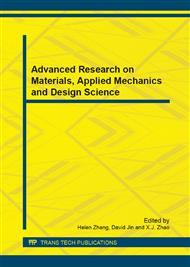p.36
p.40
p.44
p.48
p.53
p.58
p.63
p.68
p.73
Synthesis and Microwave Absorption Characteristics of Polyaniline
Abstract:
This paper aims at reporting the synthesis and microwave absorption characteristics of polyaniline (PANI). The PANI nanoparticles were synthesized by chemical oxidative polymerization method with ammonium persulfate ((NH4)2S2O8, APS) as oxidant and hydrochloric acid (HCl) for protonation of aniline. For APS/aniline mol ratio of 1, HCl concentration of 1 mol/L, reaction temperature of 5°C, the reaction time of 6h, the obtained PANI exhibits the highest value(30.9 S·cm-1)of the electrical conductivity. The structure and morphology of PANI were studied by X-ray diffraction (XRD), scanning electron microscopy (SEM), Fourier transform infrared spectrophotometer (FT-IR), ultraviolet-visible spectrophotometer (UV-Vis) analysis ways. Microwave absorbing performances were investigated using wave-guide method with vector network analyzer in 2–18 GHz. The results showed that there is a maximum absorption peak with RL= -12.63dB at 13.61GHz,the value of RL ≤−10 dB is maintained from 11.38GHz to 18GHz for the sample of the thickness for 2mm.
Info:
Periodical:
Pages:
53-57
Citation:
Online since:
June 2013
Authors:
Price:
Сopyright:
© 2013 Trans Tech Publications Ltd. All Rights Reserved
Share:
Citation:


